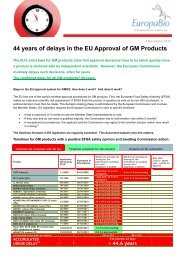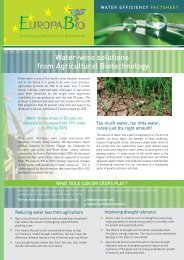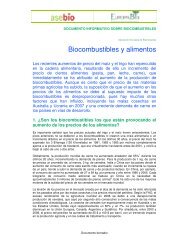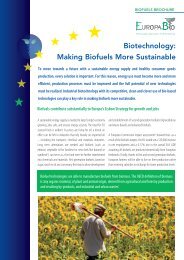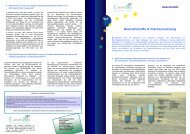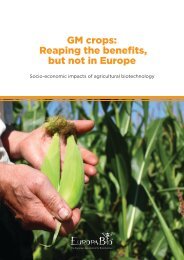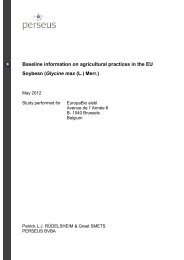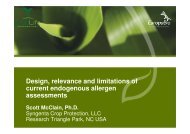Baseline information on agricultural practices in the EU ... - Europabio
Baseline information on agricultural practices in the EU ... - Europabio
Baseline information on agricultural practices in the EU ... - Europabio
You also want an ePaper? Increase the reach of your titles
YUMPU automatically turns print PDFs into web optimized ePapers that Google loves.
years due to <strong>the</strong> formati<strong>on</strong> of sclerotia, or because it can survive <strong>on</strong> organic material and <strong>the</strong> roots of<br />
many host plants.<br />
O<strong>the</strong>r fungal diseases of high importance <strong>in</strong> Europe are Cercospora leaf spot (Cercospora beticola),<br />
powdery mildew (Erysiphe betae), rust (Uromyces beta) and Ramularia leaf spot (Ramularia beticola).<br />
Leaf spot disease may cause very heavy damages <strong>in</strong> <strong>the</strong> warmer regi<strong>on</strong>s of Sou<strong>the</strong>rn Europe.<br />
Sugar beet plants are susceptible to rhizomania ("root madness") which turns <strong>the</strong> bulbous tap root<br />
<strong>in</strong>to many small roots mak<strong>in</strong>g <strong>the</strong> crop ec<strong>on</strong>omically unprocessable. The disease is caused by <strong>the</strong><br />
Beet necrotic yellow ve<strong>in</strong> virus (BNYVV), transmitted by <strong>the</strong> protozoan Polymyxa betae. The survival<br />
structures of Polymyxa are highly resistant spores that can survive <strong>in</strong> soils for more than 15 years.<br />
Up<strong>on</strong> germ<strong>in</strong>ati<strong>on</strong> of <strong>the</strong>se structures Polymyxa zoospores with BNYVV that resides <strong>in</strong> <strong>the</strong> spores can<br />
<strong>in</strong>fect new plants.<br />
It is not possible to c<strong>on</strong>trol Polymyxa with fungicides or soil dis<strong>in</strong>festati<strong>on</strong>. Us<strong>in</strong>g tolerant varieties is<br />
<strong>the</strong> <strong>on</strong>ly technique to be able to c<strong>on</strong>t<strong>in</strong>ue grow<strong>in</strong>g beets. In France, <strong>the</strong> Ne<strong>the</strong>rlands and many o<strong>the</strong>r<br />
countries 100% of <strong>the</strong> varieties are (partially) tolerant to BNYVV (CIBE-CEFS, 2010, ITB, IRS). Early<br />
sow<strong>in</strong>g and a good soil structure (water dra<strong>in</strong><strong>in</strong>g) delay <strong>in</strong>festati<strong>on</strong> limit<strong>in</strong>g damage (IRS). Recently<br />
classic rhizomania tolerance seems to be broken <strong>in</strong> some fields <strong>in</strong> south of France. In <strong>the</strong>se areas <strong>the</strong><br />
growers need to use varieties comb<strong>in</strong><strong>in</strong>g 2 sources of tolerance.<br />
Strict c<strong>on</strong>trols are enforced <strong>in</strong> European countries to prevent <strong>the</strong> spread, but it is already endemic <strong>in</strong><br />
some areas (EPPO, A2 list). Up to 50-70% of root yield and two to more than four percentage po<strong>in</strong>ts<br />
of sugar c<strong>on</strong>tent may be lost with severe attacks of rhizomania (EPPO). BNYVV is regulated with<strong>in</strong><br />
<strong>the</strong> European Uni<strong>on</strong> <strong>in</strong> protected z<strong>on</strong>es, currently Brittany (FR), F<strong>in</strong>land, Ireland, <strong>the</strong> Azores (PT), and<br />
Nor<strong>the</strong>rn Ireland (GB) 2 .<br />
To determ<strong>in</strong>e whe<strong>the</strong>r and when it is necessary to carry out chemical plant protective measures (i.e.<br />
spray<strong>in</strong>g pesticides), farmers c<strong>on</strong>t<strong>in</strong>uously m<strong>on</strong>itor <strong>the</strong> crop for signs of stress and are regularly<br />
<strong>in</strong>formed about wea<strong>the</strong>r c<strong>on</strong>diti<strong>on</strong>s likely to favour <strong>the</strong> development of specific pests and diseases by<br />
e.g. technical research <strong>in</strong>stitutes or advisory services dedicated to sugar beet. In <strong>the</strong>ir decisi<strong>on</strong> crop<br />
damage thresholds are taken <strong>in</strong>to account.<br />
Diseases affect<strong>in</strong>g beet <strong>in</strong> store <strong>in</strong>clude scab (Streptomyces scabies), phoma (Phoma betae), wetrot<br />
(Phytophthora megasperma), violet root rot (Helicobasidium purpureum) and rots caused by Fusarium<br />
spp., Penicillium spp., Botrytis c<strong>in</strong>erea, Rhizopus nigricans and Sclerot<strong>in</strong>ia sclerotiorum (BBRO).<br />
2 Council Directive 2000/29 of 8 May 2000 <strong>on</strong> protective measures aga<strong>in</strong>st <strong>the</strong> <strong>in</strong>troducti<strong>on</strong> <strong>in</strong>to <strong>the</strong><br />
Community of organisms harmful to plants or plant products and aga<strong>in</strong>st <strong>the</strong>ir spread with<strong>in</strong> <strong>the</strong><br />
Community. OJ L 169, 10/07/2000, p.1-112. and<br />
Commissi<strong>on</strong> Regulati<strong>on</strong> EC/690/2008 of 4 July 2008 recognis<strong>in</strong>g protected z<strong>on</strong>es exposed to<br />
particular plant health risks <strong>in</strong> <strong>the</strong> Community. OJ L 193, 22/07/2008, p.1-6.<br />
Page 20 of 66



